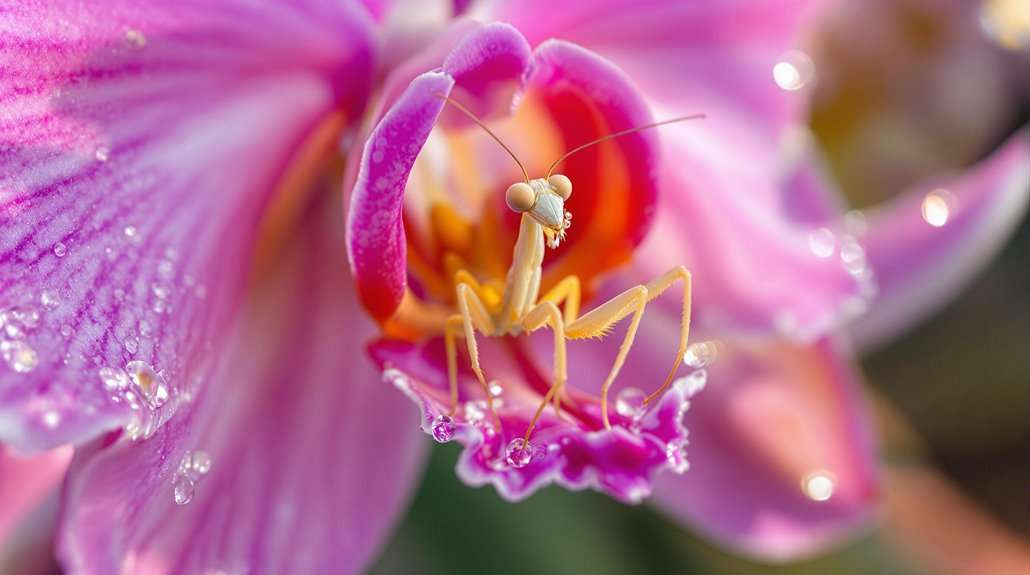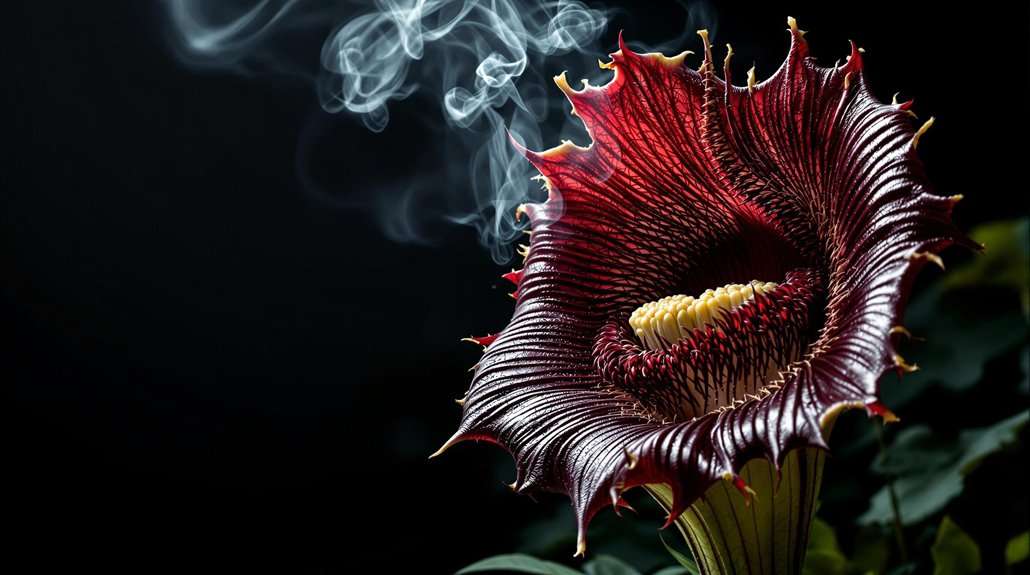Weird Facts About Plants
You'll be amazed to learn that plants are far more sophisticated than they appear. Some can mimic other species perfectly, like the chameleon vine that changes its leaves to match neighboring plants. They're capable of communicating through chemical signals and underground fungal networks, warning others of threats. Plants can even generate their own heat and solve complex problems without a brain. They've adapted to survive in extreme conditions, from 6km above sea level to heavy metal-contaminated soils. From the world's fastest-growing plant that doubles in size daily to flowers that can kill, nature's green kingdom holds countless mysterious abilities waiting to be discovered.
This post may contain affiliate links. If you make a purchase through these links, I may earn a commission at no additional cost to you. Additionally, portions of this post may be generated using artificial intelligence (AI) technology. While we strive for accuracy, please be aware that AI-generated content may not always be perfect and should be fact-checked when necessary.
The Spatula Scoops
- The chameleon vine can mimic multiple different host trees simultaneously, changing its leaves' size, shape, color, and orientation.
- Wolffia, the world's fastest-growing plant, doubles its size in just 24 hours despite being extremely small.
- Plants communicate through underground fungal networks, sharing information and nutrients with neighboring plants.
- The Rafflesia arnoldii produces the world's largest individual flower, measuring 1.5 meters across.
- Plants can survive at extreme altitudes of 6,150 meters, developing high-sugar antifreeze to withstand bitter winters.
Nature's Most Bizarre Mimics

Among nature's most fascinating adaptations, the Boquila trifoliolata stands out as a master of disguise. You'll find this remarkable vine, also known as the chameleon vine, changing its leaves to match those of nearby plants – even when it's not touching them. What's truly incredible is that a single vine can mimic multiple different host trees simultaneously, altering everything from leaf size and shape to color and orientation.
This extraordinary plant was first discovered by plant ecologist Ernesto Gianoli in the lush rainforests of southern Chile. You might wonder how this plant achieves such precise mimicry. Scientists haven't completely figured it out yet, but they've proposed several theories. One suggests that airborne bacteria might transfer genetic material between the Boquila and its neighboring plants. Others theorize that the vine might respond to chemical signals or even possess some form of visual perception. The plant's ability to mimic artificial plants has particularly intrigued researchers, challenging traditional understanding of plant capabilities. In much the same way, a clean and well-maintained refrigerator can also reduce bacterial growth, making it an ideal environment for storing food.
This extraordinary mimicry serves a pivotal purpose: survival. By matching the appearance of less palatable plants nearby, the Boquila protects itself from hungry herbivores, demonstrating nature's remarkable capacity for adaptation.
Plants That Make Their Heat
While some plants excel at visual mimicry, others have developed an even more remarkable ability – they can generate their own heat. You'll find this fascinating adaptation in several species, including the skunk cabbage, which can warm itself up to 15-35 degrees above the surrounding air temperature, allowing it to melt through snow and bloom in early spring.
The process behind this heat generation is called thermogenesis, and it's achieved through specialized cellular respiration in the plant's mitochondria. Instead of producing ATP for energy storage, these plants channel their resources into creating heat. You'll see this particularly well demonstrated in the titan arum and dead horse arum, which use their warmth not only for survival but also to attract pollinators. This warming process helps the plants produce more fragrance and CO2, making them more attractive to potential pollinators.
What's especially interesting is how these plants can regulate their temperatures through feedback mechanisms, much like warm-blooded animals. This ability isn't just a curious oddity – it's believed to have significant evolutionary advantages, helping plants survive in cold climates and extend their growing seasons. Scientists are studying these heat-producing mechanisms, hoping to develop more frost-resistant crops for agriculture. In a similar way, researchers are exploring the benefits of CFTR modulators in treating cystic fibrosis, a genetic disorder that affects the regulation of salt and water in the body.
Underground Plant Life Secrets

You'll be amazed to learn that plants lead complex social lives beneath the soil, where vast networks of fungal connections link different species in an intricate web of nutrient sharing and communication. When you look at a forest floor, you're actually standing above an incredible system where trees store carbon and exchange resources through what scientists call the "wood wide web", a living internet of roots and fungal threads. These underground networks help plants share nutrients and information about threats, making the soil beneath your feet as busy as a social network, with fungi acting as the fiber-optic cables of the forest. These networks can span acres of soil beneath the surface, creating an extensive communication highway between different plant species.
Hidden Root Networks Connect
The underground world of plants holds an astonishing secret: a vast network of connected roots and fungi that operates like nature's own internet. You'll find thin fungal threads called hyphae weaving through the soil, connecting different plants in an intricate web known as the mycorrhizal network. These incredible networks can stretch vast distances underground, creating an expansive communication system.
Through this hidden network, you can observe remarkable interactions between plants. Larger, older trees act as hub nodes, sharing essential nutrients like carbon, nitrogen, and phosphorus with younger saplings. When you examine these connections closely, you'll discover that plants don't just share resources – they're actually communicating. If a plant faces threats from insects or disease, it'll send chemical warning signals through the fungal network to alert its neighbors.
You're looking at a system that's pivotal for ecosystem survival. This underground network helps maintain forest health by supporting weaker plants and promoting biodiversity. In poor soil conditions, you'll find plants relying heavily on these fungal partnerships for survival. The network even plays a significant role in fighting climate change by helping trees store carbon more effectively in the soil.
Carbon Storage Below Ground
Underground networks don't just connect plants – they serve as powerful carbon storage systems. You'll find that plants have developed sophisticated mechanisms for storing carbon dioxide deep beneath the surface, similar to how humans are now developing carbon capture technology. These natural systems have been perfected over millions of years, utilizing various geological formations and biological processes. The technology of carbon capture and storage helps reduce emissions from power plants just like these natural plant systems.
- Plant roots work with soil microorganisms to trap carbon in stable compounds
- Underground storage occurs through both living root systems and decomposed organic matter
- Soil aggregates form protective barriers around stored carbon
- Deep-rooted plants can store carbon at depths of several meters
- Natural carbon mineralization occurs when plant matter interacts with certain rock formations
When you look at the way plants store carbon underground, you'll notice it's remarkably similar to modern carbon capture technologies. Just as industrial systems use saline formations and mineral trapping, plants utilize natural processes to lock carbon away in soil structures. The efficiency of these biological systems is particularly impressive, as they've evolved to maximize carbon storage while maintaining essential nutrient cycles. You're witnessing one of nature's most effective climate regulation mechanisms every time you see a plant growing in soil.
Deadly Beautiful Garden Varieties
Beautiful but potentially lethal, many common garden plants harbor deadly secrets beneath their attractive exteriors. You'll find these dangerous beauties in gardens worldwide, from the striking purple blooms of Aconitum (Monkshood) to the delicate white bells of Lily of the Valley. While they're stunning additions to your landscape, you need to know about their risks. Regular washing and maintenance of bedding materials like bamboo pillows can also enhance hygiene and comfort.
Growing up to four feet tall, the dramatic monkshood stands as a towering presence in the fall garden. You might be surprised to learn that Aconitum, a longtime staple of English cottage gardens, was historically used by Romans to poison wolves and by Native Americans to arm their hunting arrows. Similarly, the Angel's Trumpet, with its dramatic pendant flowers, contains powerful toxins that can cause hallucinations and death. Even the seemingly innocent Autumn Crocus packs a deadly punch with its colchicine content. Proper care techniques, like air drying methods, can also be essential for preserving the quality of materials.
Some of these plants don't just threaten human health—they're also environmental menaces. You'll want to think twice before planting Chinese Wisteria or Tree of Heaven, as they'll aggressively overtake your garden and harm native species. If you're curious about these dangerous plants, you can visit The Poison Garden in Northumberland, where you'll find 100 varieties of toxic plants under strict security measures.
Strange Smells From The Wild

While dangerous garden plants might catch your eye, nature's most intriguing specimens often grab your attention through your nose first. You'll find some of the most fascinating examples in gardens and forests worldwide, where plants have evolved remarkable strategies to attract pollinators through scent. These odorous adaptations range from mildly unpleasant to downright offensive, yet they're perfectly designed for their purpose. Titan arum and other species can cause birth defects in livestock. The cultivation of certain crops, such as palm oil, has led to significant deforestation and habitat loss.
- Dragon Arum releases a scent like rotting flesh that's strongest in the first day of blooming
- The Corpse Flower, with its massive bloom, produces an overwhelming smell of decay
- Female Ginkgo trees drop fruits that smell distinctly like vomit due to butyric acid
- Bradford Pear trees emit a fishy odor that you can detect from surprising distances
- Skunk Cabbage lives up to its name with an aroma that mimics roadkill
You'll notice these plants often use their unpleasant scents to attract specific pollinators, particularly flies and beetles that are drawn to decomposing matter. It's a remarkable example of evolutionary adaptation, where what we find repulsive serves as a powerful attractant in nature's complex web of relationships.
Plant Survival Techniques
If you look closely at plants in the wild, you'll notice they've developed remarkable survival strategies, from storing water in thick leaves to growing protective spines. Nature's emergency plans include everything from symbiotic relationships with fungi to specialized root systems that help plants weather harsh conditions and drought. Some plants, like the one-flowered cancer root, employ parasitic feeding methods to obtain nutrients directly from host plants. While some plants camouflage themselves to avoid being eaten, others use chemical defenses or grow in dense clusters to protect against extreme temperatures, showing just how resourceful these living things can be when facing life-threatening challenges. Many plants, such as cloves, have organic farming benefits that enhance their natural defenses and promote healthy growth.
Nature's Emergency Plans
Plants possess an impressive arsenal of survival techniques that help them thrive in challenging environments. You'll find these adaptations particularly fascinating, as they've evolved to handle everything from drought to predator attacks. When conditions get tough, plants deploy specialized mechanisms that showcase nature's ingenuity. Woody plants can regenerate through severe pruning when damaged.
Here are some remarkable emergency responses plants use to survive:
- They can quickly develop shallow roots to catch rare rainfall
- Their seeds contain chemical inhibitors that prevent premature germination
- They'll shed leaves, buds, and flowers to conserve energy
- Some transform into temporary dormant states until conditions improve
- They produce defensive compounds like poisons and irritants
You'll notice these survival strategies aren't just reactive – they're carefully developed systems. When water becomes scarce, succulents activate their stored reserves while ephemeral plants race through their entire life cycle. Deep-rooted xerophytes can access underground water sources, while halophytes manage salt levels to prevent dehydration. Even in extreme environments, plants demonstrate remarkable resilience through these built-in emergency responses, which often determine the difference between survival and failure in nature's demanding conditions.
Life-Saving Plant Tricks
Nature's emergency responses are just the beginning of the remarkable survival toolkit found in the plant kingdom. You'll find fascinating adaptations like bunchberry's woody rhizomes, which create vast colonies of identical plants across the forest floor, ensuring the species' survival through genetic copies.
If you're exploring wet environments, you'll notice plants with specialized structures like stilt roots and buttress roots that keep them standing tall. Some plants have evolved drip-tipped leaves to prevent water accumulation and reduce fungal growth. These roots don't just provide stability – they're also clever nutrient collectors. In the case of pink lady slippers, you'll discover an incredible partnership with mycorrhizal fungi that can take eight years to develop, where the plant trades sugars for essential nutrients.
You might not realize it, but many plants offer practical survival applications. When you're in the wilderness, you can use cattails and bulrushes for shelter insulation, collect clean drinking water from moss, or create fire-starting material from cattail fluff. Even water purification is possible using plants like Oregon grape, which contains natural antimicrobial properties. These adaptations aren't just fascinating – they're potentially life-saving resources at your disposal.
Record Breaking Plant Growth

Record-breaking discoveries in the plant kingdom continue to push the boundaries of what we thought possible. You'll find vascular plants thriving at an astonishing 6,150 meters on Mount Shukule II in India, while algae and mosses venture even higher. As climate change progresses, you're likely to see plants climbing even further up mountains, with Tibetan species already ascending at measurable rates each year. These remarkable plants survive using high-sugar antifreeze to withstand bitter winters.
In addition, quinoa, a type of plant, can maintain its quality for several years if stored properly due to its natural durability.
When it comes to remarkable growth patterns, here's what you need to know:
- Wolffia doubles its size in just 24 hours, making it the world's fastest-growing plant
- Victoria amazonica produces leaves up to 3 meters wide, dominating water surfaces
- Rafflesia arnoldii boasts the largest individual flower at 1.5 meters across
- Balanophora involucrata's tiny flowers measure just 25 micrometers wide
- Nymphaea thermarum claims the title of smallest waterlily, with leaves smaller than a coin
You'll find these growth records aren't just botanical curiosities – they're valuable scientific resources. Scientists study these plants' unique characteristics to understand growth mechanisms, which could revolutionize agriculture and help develop more resilient crops for our changing climate.
Unexpected Plant Intelligence
Intelligence flourishes in unexpected places, and you'll find remarkable cognitive abilities in the plant kingdom that challenge traditional views of consciousness. You might be surprised to learn that plants actively communicate, solve problems, and display sophisticated adaptive behaviors that demonstrate their hidden intelligence. Many spices, such as cardamom pods, have been used for centuries to enhance flavors and aromas in various dishes, highlighting the importance of plant-based ingredients in human culture.
| Capability | Function | Example |
|---|---|---|
| Chemical Communication | Warning System | Underground chemical alerts to neighboring plants |
| Fungal Networks | Information Exchange | Nutrient sharing through mycorrhizal connections |
| Sensory Response | Environmental Adaptation | Light tracking and obstacle navigation |
When you observe plants closely, you'll notice they're constantly processing information from their environment. They'll bend towards light sources, extend their roots around obstacles to find water, and even release specific chemicals to attract helpful insects. Your garden plants are actually running complex calculations, determining ideal growth patterns and resource allocation. They're detecting vibrations, measuring light quality, and monitoring temperature changes through specialized cellular mechanisms. What's particularly fascinating is their ability to maintain these sophisticated behaviors without a central nervous system, relying instead on a decentralized intelligence that's still not fully understood by scientists.
Ancient Plant Uses

Beyond their remarkable intelligence, plants have shaped human civilization since its earliest days. You'll find evidence of their diverse uses spanning across ancient cultures, from medicine and spiritual rituals to practical applications in daily life. Our ancestors discovered countless ways to harness plants' properties, developing sophisticated knowledge that still influences modern practices.
- Egyptian physicians were using poppy extracts for pain management as early as 1550 BCE, predating modern painkillers by millennia
- Ancient Romans relied on sage to enhance memory, while Greeks turned to willow bark, containing the compound that would inspire modern aspirin
- The Phoenicians, Greeks, and Romans developed complex fabric-dyeing techniques using plants like madder root and indigo
- Frankincense and myrrh weren't just biblical gifts – they played vital roles in ancient Egyptian and Mesopotamian ceremonies
- The Mayans and Aztecs valued cacao so highly, they used its beans as currency before developing it into a sacred drink
- El Salvador's rich volcanic soil, ideal for coffee production, has contributed significantly to its economy and cultural heritage.
This extensive botanical knowledge demonstrates how deeply intertwined plant use has been with human development, contributing to medicine, commerce, and cultural practices that have endured for thousands of years.
Frequently Asked Questions
Can Plants Communicate With Each Other Through Underground Fungal Networks?
Yes, you'll find that plants can communicate through underground fungal networks, often called the "wood wide web." These networks of fungal threads (mycelium) connect plant roots, allowing them to share nutrients and warning signals about threats like insect attacks or diseases. When one plant detects danger, it'll send chemical signals through the fungal network, helping nearby plants activate their defense mechanisms before they're attacked.
Why Do Some Flowers Change Color Throughout the Day?
You'll find that flowers change color throughout the day due to several factors: temperature fluctuations, pH level changes, and light exposure. Anthocyanins, the pigments responsible for red and purple hues, are particularly sensitive to these environmental shifts. For example, morning glories undergo a metamorphosis from blue to purple as temperatures rise, while hibiscus flowers shift from yellow to red in response to changing pH levels in their cells.
How Do Plants Know Which Direction to Grow Their Roots?
Your plant's roots know where to grow through multiple sophisticated mechanisms. They're primarily guided by gravity (gravitropism), which directs the main root downward. Chemical signals from soil nutrients and microorganisms help roots navigate, while mechanical forces let them detect and grow around obstacles. Light indirectly influences root growth by affecting the plant's overall development, and hormones like auxin and ethylene coordinate these responses.
Do Plants Feel Pain When They Are Cut or Damaged?
While plants don't feel pain like humans do, they've developed sophisticated response systems to damage. You'll find they react through chemical signals like jasmonic acid and electrical impulses when cut or injured. They'll release stress hormones, activate defense mechanisms, and even warn neighboring plants through airborne chemicals. Think of it more as a complex stress response system rather than pain sensation in the way we experience it.
Can Plants Recognize Their Own Relatives Among Other Plants?
Yes, plants can recognize their relatives through chemical signals released from their roots. When you plant siblings together, they'll grow more cooperatively, allowing their leaves to intertwine and sharing resources. They'll actually behave differently with strangers, growing more competitive root systems to fight for nutrients and water. This recognition happens through root exudates, which act like a family identification system in the soil.





